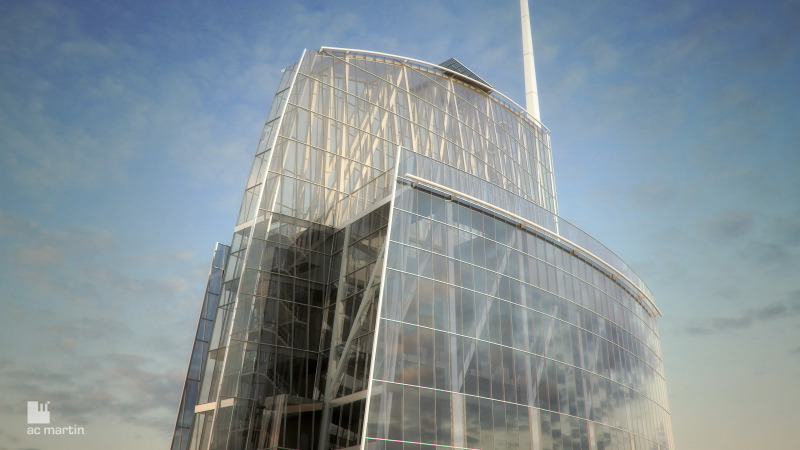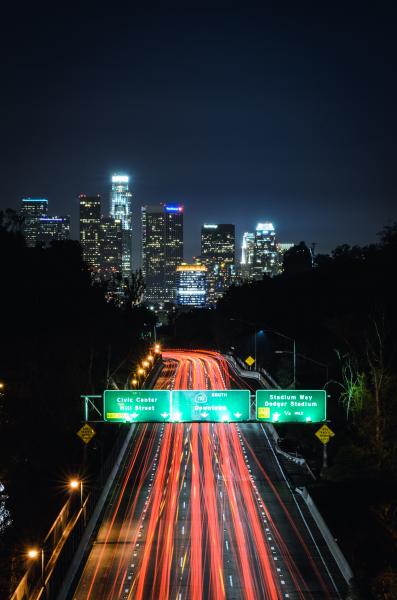Don’t Expect Anything Soon With L.A.'s New Skyscraper Regulations

This story is part of a new series about the various urban planning developments taking place in parts of downtown Los Angeles called "What Will L.A. Look Like In 20 Years?" Check back for more from this series.
No matter which vantage point you choose to look at Downtown Los Angeles, you’ll always see the same thing: high-rises with flat rooftops.
It seems strange that one of America’s leading cities would lack the defining skylines of other metropolises like New York, San Francisco and even San Diego. But this is all due to a self-imposed restriction, which was removed just over a month ago.
This was Regulation 10, which required that all buildings more than 75 feet tall to have an evacuation helipad in case the building caught on fire.
City officials lauded the removal of the measure. Mayor Eric Garcetti even called it just “one more stupid rule in Los Angeles.”
Regulation 10 was created in response to the deadly Joelma fire that killed around 200 people in São Paulo, Brazil. After the Joelma Building caught on fire during the early hours of Feb. 1, 1974, dozens of trapped office workers headed to the top of the building in hopes of a helicopter rescue. The helicopter came, but no rescue ever happened, as there simply was no space large enough for a helicopter landing atop the building.
In the 40 years since its inception, there has only been one instance of a high-rise helicopter rescue in L.A.: in 1988, the 12th floor of the First Interstate Tower (now the Aon Center), caught on fire, killing one, and injuring 49 more. Los Angeles Police Department helicopters were above the scene and ended up lifting five people to safety.
Nonetheless, many architects contend that helicopter rescues are just not very practical. The First Interstate Tower fire prompted L.A. to change its building codes, requiring all high-rises to install sprinkler systems.
The removal of Regulation 10 is “a sea change for Los Angeles design,” said Mayor Garcetti.
Local architects don't agree.
Skyscrapers cost hundreds of millions of dollars, take years to build, and simply aren’t built very frequently, especially in an already developed urban area, experts say.
“Somebody has to want to build a building and have the money to build a building,” said Carey McLeod, a principal with AC Martin Partners. The architects are behind the new Wilshire Grand project, a 1,100-foot luxury hotel being constructed in the financial district. “When economic times are good, oftentimes you’ll see new buildings. And when you’re in a recession, oftentimes you don’t see new buildings.”
L.A. architect Warren Techentin said the removal of Regulation 10 was overhyped. “It’s not like people were sitting there mashing their teeth about how they were being held back from building fancy tops on buildings,” he said.

Will Wright, director of government and public affairs at the L.A. chapter of the American Institute of Architects, agreed with Techentin. “This is really more of symbolic move, I don’t see it changing a lot," he said. "I don’t think L.A. will ever be Manhattan."
But this does not mean L.A. will be forever stuck with flat roofs. The Wilshire Grand, which began construction in 2012, could serve as an example of what's to come. In exchange for installing more skyscraper safety features, city officials dropped the mandatory emergency helipad and replaced it with the requirement of a much smaller service helipad.
According to McLeod, the new tower was designed with state-of-the-art safety features, including a high-speed elevator dedicated to firefighters, a third emergency stairwell and video cameras outside each elevator door that firefighters can access to determine the state of a fire on each floor. These features are located within a thick concrete shear core, which enhances their durability in the event of a natural disaster.
When the $1 billion building opens in 2017, visitors will be able to visit a “sky lobby” and infinity pool 73 stories above the ground. The open rooftop plaza is intended to provide a new way of experiencing downtown and its surrounding views.
While this is a more commercial approach at defining what a high-rise rooftop can be, the “sky is the limit in terms of what’s possible, only limited by engineering and building materials,” said Michael Woo, a former L.A. City Planning Commissioner and current dean of the College of Environmental Design at California State Polytechnic University, Pomona.
.jpg)
Architects are also encouraged to take environmental approaches and create green rooftops or install wind turbines, breaking away from the pyramids and spires that dominate other iconic high-rises like the Empire State, Chrysler and Transamerica Buildings.
Now, the hope is that the recently updated building codes will give architects the artistic freedom to create a more striking skyline that is unique to Los Angeles.
“It’s important architecturally how you finish a building. The top of buildings have really set an example for the civic presence of many cities,” said Techentin. “Having the flexibility to not only incorporate technologies but really to make an architectural statement is really important for a city and its people.”
Reach Web Producer/Staff Photographer Benjamin Dunn here.



